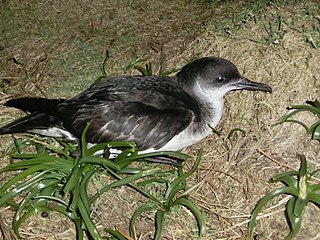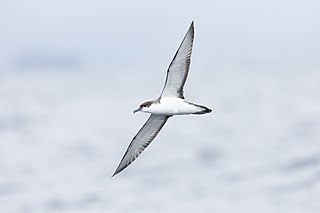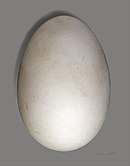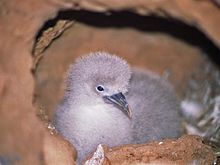
Shearwaters are medium-sized long-winged seabirds in the petrel family Procellariidae. They have a global marine distribution, but are most common in temperate and cold waters, and are pelagic outside the breeding season.

The family Procellariidae is a group of seabirds that comprises the fulmarine petrels, the gadfly petrels, the diving petrels, the prions, and the shearwaters. This family is part of the bird order Procellariiformes, which also includes the albatrosses and the storm petrels.

The Manx shearwater is a medium-sized shearwater in the seabird family Procellariidae. The scientific name of this species records a name shift: Manx shearwaters were called Manks puffins in the 17th century. Puffin is an Anglo-Norman word for the cured carcasses of nestling shearwaters. The Atlantic puffin acquired the name much later, possibly because of its similar nesting habits.

The sooty shearwater, or tītī, or muttonbird, is a medium-large shearwater in the seabird family Procellariidae. In New Zealand, it is also known by its Māori name tītī, and as muttonbird, like its relatives the wedge-tailed shearwater and the Australian short-tailed shearwater.

The Christmas shearwater or ʻaoʻū is a medium-sized shearwater of the tropical Central Pacific. It is a poorly known species due to its remote nesting habits, and it has not been extensively studied at sea either.

The Antarctic petrel is a boldly marked dark brown and white petrel, found in Antarctica, most commonly in the Ross and Weddell Seas. They eat Antarctic krill, fish, and small squid. They feed while swimming but can dive from both the surface and the air.

The short-tailed shearwater or slender-billed shearwater, also called yolla or moonbird, and commonly known as the muttonbird in Australia, is the most abundant seabird species in Australian waters, and is one of the few Australian native birds in which the chicks are commercially harvested. It is a migratory species that breeds mainly on small islands in Bass Strait and Tasmania and migrates to the Northern Hemisphere for the boreal summer.

The great frigatebird is a large seabird in the frigatebird family. There are major nesting populations in the tropical Pacific Ocean, such as Hawaii and the Galápagos Islands; in the Indian Ocean, colonies can be found in the Seychelles and Mauritius, and there is a tiny population in the South Atlantic, mostly on and around St. Helena and Boatswain Bird Island.

Procellaria is a genus of Southern Ocean long-winged seabirds related to prions, and within the order Procellariiformes. The black petrel ranges in the Pacific Ocean, and as far north as Central America. The spectacled petrel is confined to the Atlantic Ocean, and the Westland petrel to the Pacific Ocean. The white-chinned and grey petrel range throughout the higher latitudes of the Southern Ocean.

The flesh-footed shearwater is a medium-sized shearwater. Its plumage is black. It has pale pinkish feet, and a pale bill with a distinct black tip. Together with the equally light-billed pink-footed shearwater, it forms the Hemipuffinus group, a superspecies which may or may not have an Atlantic relative in the great shearwater. These large shearwaters are among those that have been separated into the genus Ardenna. Recent genetic analysis indicates evidence of strong divergence between Pacific colonies relative to those in South and Western Australia, thought to be explained by philopatry and differences in foraging strategies during the breeding season.

The blue petrel is a small seabird in the shearwater and petrel family, Procellariidae. This small petrel is the only member of the genus Halobaena, but is closely allied to the prions. It is distributed across the Southern Ocean but breeds at a few island sites, all close to the Antarctic Convergence zone.

Muttonbirding is the seasonal harvesting of the chicks of petrels, especially shearwater species, for food, oil and feathers by recreational or commercial hunters. Such hunting of petrels and other seabirds has occurred in various locations since prehistoric times, and there is evidence that many island populations have become extinct as a result. More recently ‘muttonbirding’ usually refers to the regulated and sustainable harvesting of shearwaters in Australia and New Zealand. These include the short-tailed shearwater, also known as the yolla or Australian muttonbird, in Bass Strait, Tasmania, as well as the sooty shearwater, also known as the titi or New Zealand muttonbird, on several small islands known as the Muttonbird Islands, scattered around Stewart Island in the far south of New Zealand.

Buller's shearwater is a Pacific species of seabird in the family Procellariidae; it is also known as the grey-backed shearwater or New Zealand shearwater. A member of the black-billed wedge-tailed Thyellodroma group, among the larger shearwaters of the genus Ardenna, it forms a superspecies with the wedge-tailed shearwater.

The fork-tailed storm petrel is a small seabird of the storm petrel family Hydrobatidae. It is the second-most abundant and widespread storm petrel and is the only bird in its family that is bluish-grey in colour.

The Bonin petrel or nunulu is a seabird in the family Procellariidae. It is a small gadfly petrel that is found in the northwest Pacific Ocean. Its secretive habits, remote breeding colonies and limited range have resulted in few studies and many aspects of the species' biology are poorly known.

The grey petrel, also called the brown petrel, pediunker or grey shearwater is a species of seabird in the Procellariidae, or petrel family. It is pelagic and occurs in the open seas of the Southern Hemisphere, mainly between 32°S and 58°S.

The Tahiti petrel is a medium-sized, dark brown and white seabird found across the Pacifc Ocean. The species comprises two subspecies: P. r. rostrata which breeds in the west-central Pacific Ocean, and P. r. trouessarti which breeds in the tropical and subtropical Pacific Ocean. The Tahiti petrel belongs to the Procellariidae family and is the most studied member of the Pseudobulweria genus which comprises three critically endangered species. Similarly, the Tahiti petrel is considered near threatened by the 2018 IUCN Red List of Threatened Species. Threats include introduced rats, feral cats, pigs, dogs, nickel mining, and light pollution.
























